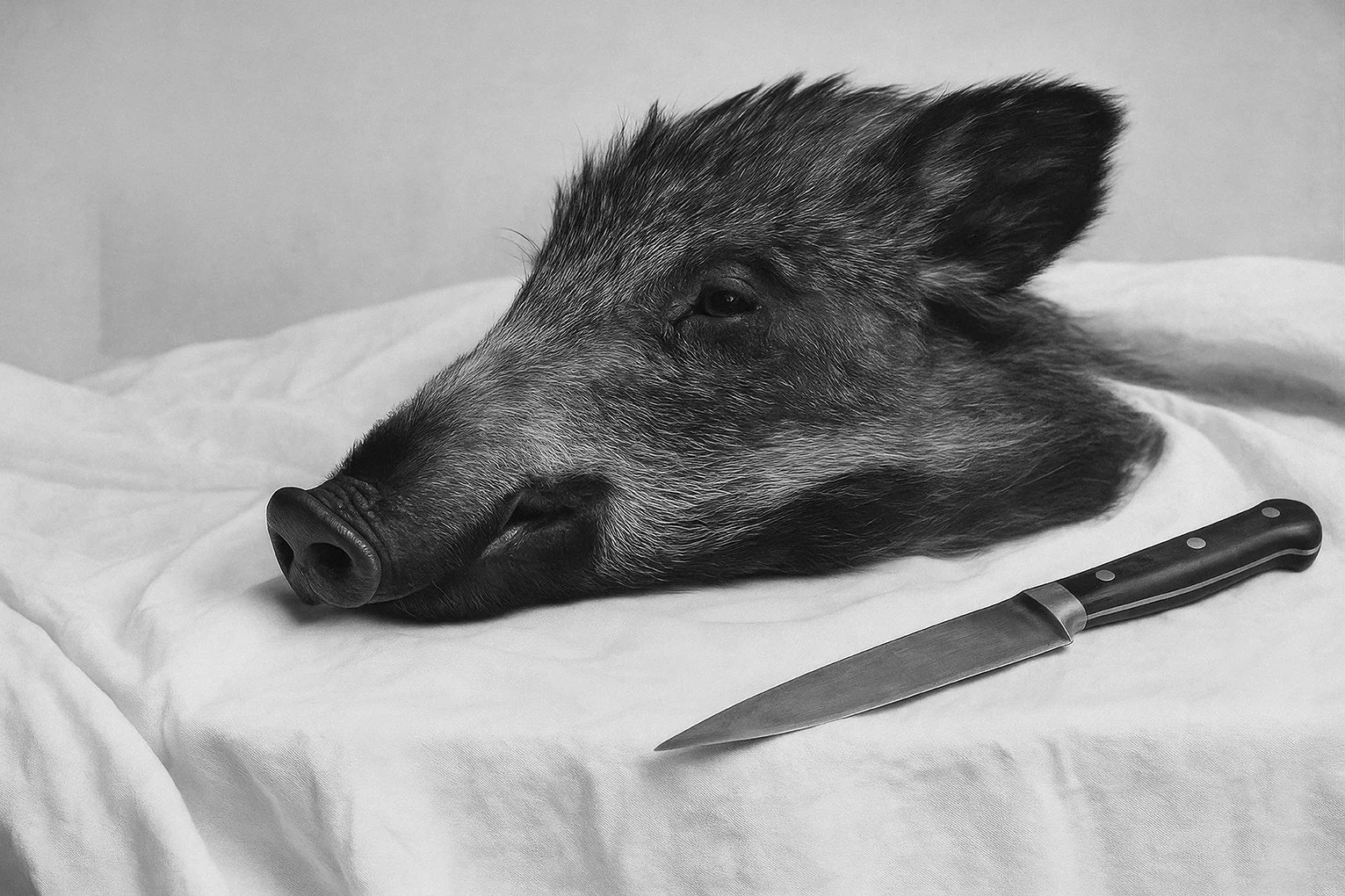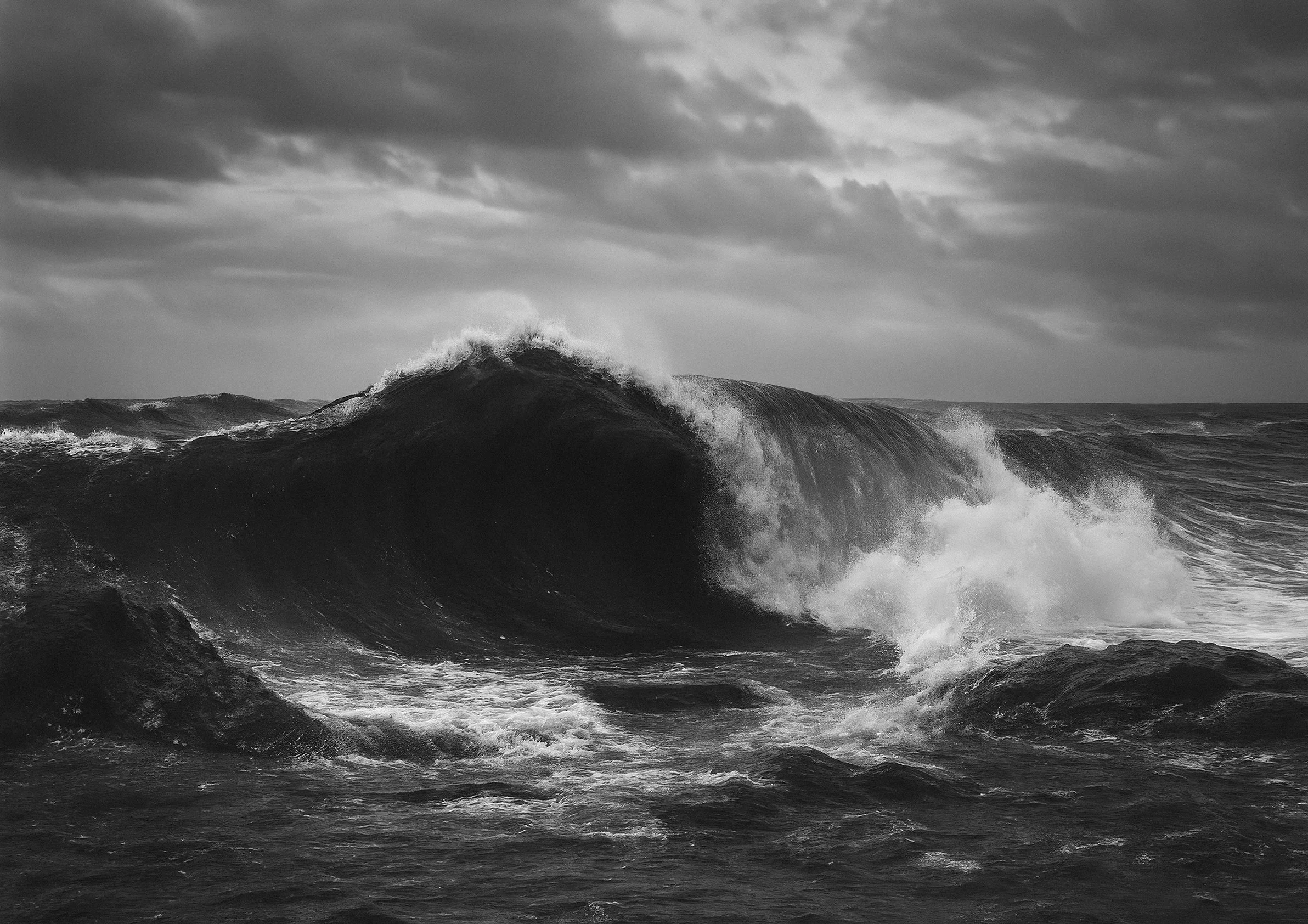
TUHEADS
波が戻らない日、私たちは何を“見た”と信じるのか。
On the day the waves do not return, what can we truly believe we have “seen”?
23rd August - 20th September, 2025
OPEN 12:00 - 20:00 / CLOSED: Tuesday, Wednesday and Thursday
OPENING RECEPTION: 23rd August 6PM - 8PM
このたびLOWWでは、一年ぶりにTUHEADSの個展「波が戻らない日、私たちは何を“見た”と信じるのか。 」を開催いたします。
AI技術を駆使しながらも、彼ら独自の世界観を構築することで国内外でも好評と期待を得ている彼らの新作は、ギュスターヴ・クールベの作品を考察しながら、知覚、記憶、想像などテーマに深く切り込みます。前作のエドゥアール・マネから続く彼らのプロジェクトの根底にある、解釈と変容を繰り返しながら、主体性と客観性の狭間で起こる過程を選びとることに挑戦しています。
本展が、これまでとこれからの世界に起こる予見をいち早く提示した新作の展覧会、ぜひご覧ください。
波が戻らない日、私たちは何を“見た”と信じるのか。
波、雪、痕跡――これらは本質的に可変的で、時間とともに消滅し、同一のかたちをとどめることができない現 象である。 しかし人間は、それらの刹那的な出現を「見た」と信じ、知覚と記憶の連続体のなかに“イメージの断片”として保 存し続ける。 本展の作品群は、こうした「とどまることのできないもの」の経験を、人工知能(AI)という21世紀的な知覚装置 /記号生成装置を介して再構成・再編集する実践である。
19世紀のリアリズム絵画を牽引したギュスターヴ・クールベ(Gustave Courbet)は、自然を理想化や象徴化の 対象とするのではなく、「ここにある自然」の現前性を主題化した。 クールベの作品における「見ること」は、まさに物質性・時間性・場所性に根ざしたものであった。
同時代、写真という新たなメディウムが登場し、視覚芸術における“記録”と“現実”の境界は大きく再編成された。 ウォルター・ベンヤミン(Walter Benjamin)が指摘したように、写真と複製技術の発展は、芸術作品の「アウラ」 の解体を引き起こし、「見る」という行為自体の制度的基盤を動揺させたのである。
20世紀以降、写真、映像、デジタルメディアは、「現実の断片」を機械的に切り取り、増殖・流通させる装置として 発展してきた。 こうしたメディア技術の進化は、「見ること」が単なる知覚の受動的な受け入れではなく、「編集」「構築」「再文脈 化」のプロセスであることを明らかにした。
杉本博司(Hiroshi Sugimoto)が問うた「時間の厚み」や、リチャード・プリンス(Richard Prince)、シンディ・ シャーマン(Cindy Sherman)の再撮影的実践は、現代美術における「イメージの運動」とその反復性・連鎖性 を浮き彫りにするものである。
現代においては、人工知能によるイメージ生成が、写真や絵画の「記録性」「リアリティ」を根本的に変容させつ つある。 AIは、膨大な画像データベースを横断し、非人間的なアルゴリズム的操作によって「かつて誰も見たことのない 像」を出力する。 この生成過程において、「見る」という行為そのものが、知覚・記憶・想像・情報・演算の総体として再定義され る。
認知科学やメディア論においては、「見る」ことは単なる情報受容ではなく、脳内での予測・再構成・フィードバッ クの連続的な操作として理解される。 私たちがAIによる生成画像に「リアルさ」や「既視感」を感じるのは、知覚経験と記憶の編集的な結合――すな わち、記号論的ネットワークの動員――が生み出すものである。
「波が戻らない日、私たちは何を“見た”と信じるのか。」 この問いは、現実の消滅、記憶の曖昧さ、そして「見る」という認知・メディア的プロセスの根源的不確かさを、芸 術という編集装置の上に露呈させるものである。
本展に並ぶ像は、消えゆく現象とその痕跡、イメージ史と情報技術、個人の記憶と集合的データが交錯する連 鎖の断片であり、「リアリティ」や「見ること」そのものを再考するための批評的契機となるだろう。
どこまでが現実で、どこからが幻なのか。ただ「見る」ことの行方だけが、静かにここに在りつづけている。
TUHEADS
On the day the waves do not return, what can we truly believe we have “seen”?
Waves, snow, and traces—these are, by nature, mutable phenomena that disappear with time and can never retain the same form. Yet, humans believe that they have “seen” these fleeting appearances, continuously preserving them as fragments of images within the continuum of perception and memory.
The works in this exhibition constitute a practice of reconstructing and re-editing such experiences of the “ungraspable” through artificial intelligence (AI), a perceptual and semiotic apparatus of the 21st century.
Gustave Courbet, who led the realism movement in nineteenth-century painting, did not treat nature as an object of idealization or symbolization, but rather foregrounded the presence of “nature here and now.” In Courbet’s work, “seeing” was rooted in materiality, temporality, and spatiality.
Around the same time, the emergence of photography as a new medium radically reorganized the boundaries between “documentation” and “reality” within visual art. As Walter Benjamin noted, the development of photography and techniques of reproduction brought about the dissolution of the “aura” of artworks, destabilizing the very institutional foundations of seeing.
Since the twentieth century, photography, moving images, and digital media have developed as devices that mechanically capture, multiply, and distribute “fragments of reality.” The evolution of these media technologies has made clear that “seeing” is not a passive acceptance of perception, but a process of “editing,” “constructing,” and “recontextualizing.” Hiroshi Sugimoto’s inquiry into the “thickness of time,” along with the re-photographic practices of Richard Prince and Cindy Sherman, reveal the movement of images and their repetition and chains within contemporary art.
In the present age, image generation by artificial intelligence is fundamentally transforming the “documentary” and “reality” functions of photography and painting. AI traverses vast image databases, using non-human algorithmic operations to output “images that no one has ever seen before.” In this generative process, the act of “seeing” itself is redefined as an aggregate of perception, memory, imagination, information, and computation.
In cognitive science and media theory, “seeing” is understood not as mere reception of information, but as a continuous process of prediction, reconstruction, and feedback within the brain. When we sense “reality” or “déjà vu” in AI-generated images, it is the editorial binding of perceptual experience and memory—that is, the mobilization of semiotic networks—that produces such effects.
“On the day the waves do not return, what can we truly believe we have ‘seen’?” This question exposes, upon the editing apparatus called art, the disappearance of reality, the ambiguity of memory, and the fundamental uncertainty of “seeing” as a cognitive and media process.
The images assembled in this exhibition are fragments of vanishing phenomena and their traces, intersections of the history of images and information technologies, the memories of individuals and collective data—critical opportunities for rethinking “reality” and the very act of seeing.
Where does reality end, and illusion begin? Perhaps only the trajectory of “seeing” remains here, quietly persisting.
TUHEADS
TUHEADS
1982,1990 日本生まれ 東京を拠点に活動。
テクノロジーが私達の歴史やアイデンティティ、創造性や感性にどのように影響を与えているかを、デジタルメディアや人工知能などの手法で表現しています。テクノロジーが持つ記録や操作、学習や生成の可能性を探りながら、私達の記憶や自己表現、芸術的な表現や評価に対する信頼性や価値、基準や意味を問い直しています。
TUHEADS
Born in Japan in 1982, 1990. Based in Tokyo.
We use digital media, artificial intelligence and other methods to express how technology affects our history, identity, creativity and sensibility. By exploring the recording, manipulation, learning and generative potential of technology, they question the reliability, value, standards and meaning of our memories, self-expression, artistic expression and appreciation.




